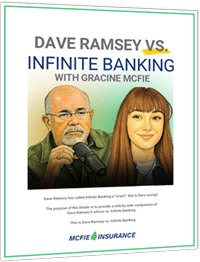317-912-1000
317-912-1000

I want the reader to understand I agree with most of what David Ramsey teaches. I lived his model of “financial peace” until I was 45 years old and have proved most of his money “makeover” theories, including being out of debt and paying cash for everything. I even purchased my own home with cash about 9 years after Dave Ramsey filed for bankruptcy. In line with what Dave Ramsey recommends about life insurance, I owned a lot of term life insurance back then. I still own a lot of term life insurance because I believe, just like Ramsey does, that term life insurance (for a certain age group and specific health classes) is the cheapest and best way to protect future income– which is exactly what life insurance is all about.[i] Yet when it comes to whole life insurance products, I believe that Dave Ramsey’s life insurance consultation could be more forthright. Let’s take a look at Dave Ramsey’s life insurance advice regarding term and whole life.
The 2010 official publication of the American Council of Life Insurers states:
“Of new individual life policies purchased in 2010, 39 percent, or 3.8 million, were term insurance, totaling $1.1 trillion, or 69 percent, of the individual life face amount issued. The most popular form of term insurance is level term, which offers a fixed premium.”[ii]
This fact about life insurance sales leaves Mr. Ramsey facing a tremendous credibility gap when he states in 2010 that
“…over 70 percent of the life insurance policies sold today are cash value policies.”[iii]
His statement saying, “Do not invest money in life insurance”[iv] is also misleading as life insurance is not an investment according to state insurance commissioners.
“Life insurance isn’t an investment. An investment is a financial risk – you might make money, but you also might lose some or all of your investment. In contrast, life insurance pays a guaranteed death benefit.”[v]
Is it unreasonable to expect someone to understand the differences between whole life vs term life insurance if they are going to be giving people advice about these products?
Dave Ramsey’s term life insurance argument claims that for a 30-year-old male, “20-year-level term insurance with coverage of $125,000, will cost only $7 per month, not $100″[vi] which is the price he states $125,000 of whole life coverage would cost.
As of this writing, a 20-year level term policy with $125,000 of coverage on a healthy 30-year-old male costs $11.79 per month, not $7. This means Ramsey is using premium costs for term insurance which favor his opinion by over 40%.[vii]
What I find most objectionable about the Dave Ramsey insurance discussion(s), is that Ramsey avoids a complete analysis of the specifics. For example, Ramsey completely ignores the fact that several mutually held or mutually owned life insurance companies have provided dividends to their participant owners (the participating whole life insurance policy owners) for the past consecutive 121[viii], 130 [ix], and even 144 years.[x] Ramsey avoids addressing these exceptional facts about life insurance while boldly stating that you can earn a 12% rate of return by investing $500 a month in an average mutual fund.
Interestingly, I have yet to find a mutual fund that will pay me a 12% rate of return on my first investment of $500, let alone on any subsequent $500 investments.
 |
Dave Ramsey vs Infinite Banking Instant Download Dave Ramsey has called Infinite Banking a "scam". But is Dave wrong? Side-by-Side review. |
Furthermore, Ramsey is silent about paid-up additional insurance riders. These riders, which can be added to some whole life policies, would alter the story that Ramsey has elected to tell. Neglecting this topic he states, “All of the $93 per month disappears in commissions and expenses for the first three years. After that, the return will average 2.6% per year for whole life…”[xi] Adding a paid-up additional insurance rider (PUAR) to a whole life policy on a healthy 30-year-old male, however, would allow the owner to easily allocate 60% of total premium paid (depending on class, and insurability, etc.) towards the PUAR.
This design greatly enhances the cash value of a policy beginning in year one.[xii] It also dramatically decreases the commissions earned on this type of policy versus policies that have no PUAR attached. If, in addition to the (PUAR), an additional term rider is added to the policy, the guaranteed cash values can swell to even larger amounts in year one.
Finally, when Ramsey does speak of returns, his assertions are misleading. Dave Ramsey speaks only of the average rate of return, and averages are just averages– they do not reflect the actual rate of return.
For example, If you add up every number from the Dow Jones from 1930 until 2011, the return “averages” 6.31%. However, this is an “actual” return of only 4.31%. The 2% difference between average vs. actual might not seem like a big deal, but it works out to be the difference between having $142k vs. only $30k! As you can see, the impact of evaluating average returns as the only measurement can be devastating.[xiii]
Did you know you can earn an average rate of return and still lose money? Watch this video on Average vs Actual Rate of Return.
Even when Ramsey does refer to average rates, it is obvious to anybody with a basic knowledge of life insurance that he is using life insurance products that have not been designed to provide high cash values early on in the contract. The facts are, participating whole life insurance products designed to hold large amounts of paid-up additional insurance (using a rider attached to the policy) can earn a guaranteed “return,” just as Ramsey states, of around 2.6%. Yet, the fact the owner has the ability to borrow against the policy without penalty and use the capital elsewhere is entirely left out in Ramsey’s message!
In short, the Dave Ramsey life insurance paradigm doesn’t provide the whole picture of life insurance when it comes to term vs. whole life, paid-up additions, and rates of return. When comparing permanent life insurance cash values to investment returns, plus the purchase of term life insurance, one needs to be aware that the buildup of non-guaranteed cash values in permanent whole life insurance compares favorably to the non-guaranteed investment results which Ramsey says is a better choice.
Ramsey says he has a better plan, but I can’t see how his plan is distinguishable from the plan which I faithfully followed until I was 45 years old. That plan left me tired and weary. I was working five to seven days a week, from 7:00 am to 8:30 pm daily. There was no vacation time, little family time, and no humanitarian or volunteer time—for me or my family. Yes, I was debt-free; I literally paid cash for everything. Yes, my house was paid off. I had accomplished that by age 35, 22 years earlier than Ramsey says his hypothetical male will be able to do following his plan.[xv] But I never experienced the financial peace or freedom which Ramsey promised. And even more sobering, I had NO availability or manageability of my hard-earned equity.
That experience is why I value whole life insurance. Participating whole life insurance provides me with guaranteed, available, equity which I can manage anytime I desire by exercising the loan option guaranteed to me in all of my whole life policy contracts. Knowing this provides me with financial peace and freedom which Dave Ramsey’s term life insurance program never did. Furthermore, because I believe I need to comply with Proverbs 13:22, which encourages me to leave an inheritance to my children’s children, and not be selfish and stop my life insurance coverage when I’m 65 or 70 leaving no future income for my children or widow, I can’t, in good faith, endorse Dave Ramsey’s life insurance recommendations.
I want my family and my clients to have both the $700,000 Ramsey says he can accumulate with his plan plus the millions that will be paid out from the permanent whole life insurance policies which I own on my life, along with any term policies I still own at that time. Sadly, with Dave’s plan, it is not unreasonable to suspect that you could outlive the $700,000 that he projects you might have by age 57 because according to the 2001 Commissioners Standard Ordinary Single Life Expectancy Table, a healthy 57-year-old male has a life expectancy of 26.46 more years while a super preferred 57-year-old male has 27.69 more years to live. Based on these statistics, consider the $700,000 you have tucked away at age 57…it will have to last you until you are at least 83 years old.
Money can never replace a life lost. Yet I have never delivered a death benefit where the beneficiary told me that I was delivering too much money. I appreciate Dave Ramsey for what he teaches concerning saving, living on what you make, and keeping out of debt, but his piecemeal discussion about permanent whole life insurance is dangerously misleading. Participating whole life insurance products are very sound products that are based on historical and actuarial data. They can consistently keep pace, if not outperform, Ramsey’s paradigm of buying term and investing the difference when used for assisting the management of real costs found throughout one’s lifetime. Remarkably, with a well-designed whole life policy, one can typically recover more than the cost of premiums paid within the first 7 to 15 years, which is a very short time in the financial world. If the policy owner leverages the cash values in these policies that typical 7-15 year period can be reduced significantly making the ownership of participating whole life insurance not only a tremendous asset but an unmatched financial tool in which those who love life and desire to accept full financial blessings should own and utilize.
To see customized life insurance illustrations for your situation call our office to set up a complimentary strategy session 1-866-502-2777. To read more about using cash value life insurance I recommend reading my book Winning Your Financial GAME.
 Tomas P. McFie DC PhD
Tomas P. McFie DC PhD
Tom McFie is the founder of McFie Insurance and co-host of the WealthTalks podcast which helps people keep more of the money they make, so they can have financial peace of mind. He has reviewed 1000s of whole life insurance policies and has practiced the Infinite Banking Concept for nearly 20 years, making him one of the foremost experts on achieving financial peace of mind. His latest book, A Biblical Guide to Personal Finance, can be purchased here.
Footnotes:
[i] tdi.texas.gov/pubs/consumer/cb018.html, Texas Department of Insurance
[ii] 2011 Life Insurers Fact Book, pg. 64, American Council of Life Insurers
[iii] Dave Ramsey, The Truth About Life Insurance, daveramsey.com, October 25, 2010
[iv] Ibid
[v] tdi.texas.gov/pubs/consumer/cb018.html, Texas Department of Insurance
[vi] Dave Ramsey, The Truth About Life Insurance, daveramsey.com, October 25, 2010
[vii] 20 year level term quote as of June, 2013
[viii] 2013 Dividend Scale Security Mutual Insurance, Kevin J. McKeown CPA CLU, ChFC Senior Vice President
[ix] Dividends Effect on Participating Whole Life Insurance, American United Life Insurance Company, page 4
[x] MassMutual Announces $1.39 Billion Record Dividend Payout for Policy owner’s, October 29, 2012
[xi] Dave Ramsey, The Truth About Life Insurance, daveramsey.com, October 25, 2010
[xii] Illustrations run with three major mutual life insurance carriers as of June, 2013
[xiii] Solving the Myth of Rate of Return, Fox Business, Erik Krom, April 30, 2012
[xiv] Thomas Young, Life Insurance will it pay when I die, pg. 69
[xv] Dave Ramsey, The Truth About Life Insurance, daveramsey.com, October 25, 2010
[xvi] Forbes Personal Finance, After The Fiscal Cliff Deal: Estate and Gift Tax Explained: Deborah L. Jacobs, 1/2/2033
[xvii] 2011 Life Insurers Fact Book, pg. 64, American Council of Life Insurers